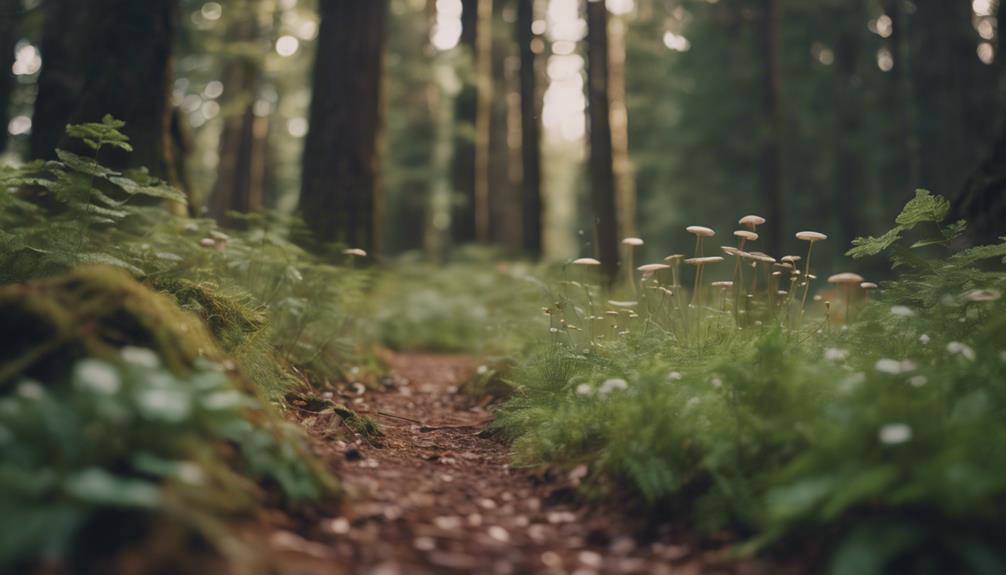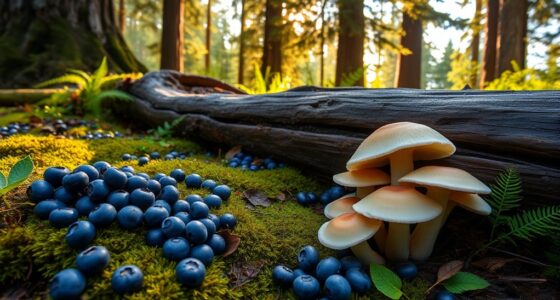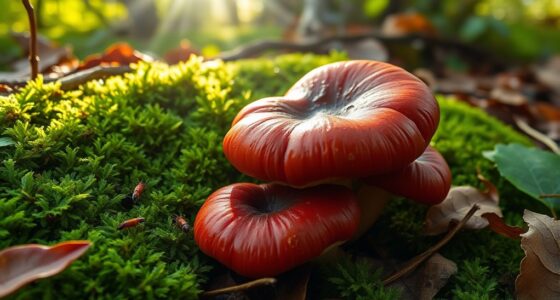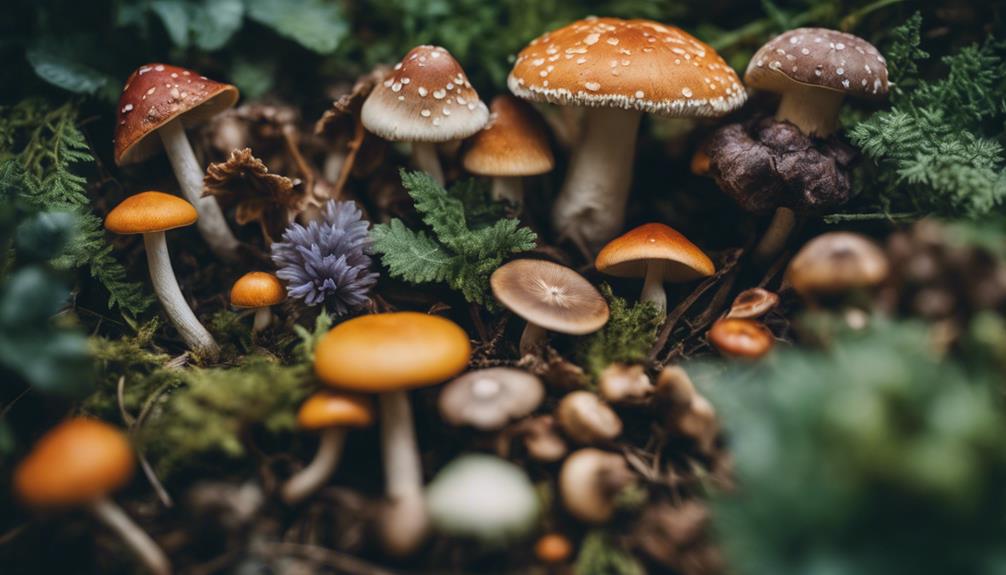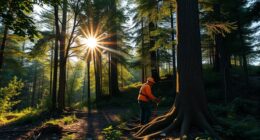You're likely to find that 75% of national parks allow foraging for personal consumption or traditional use, but regulations vary greatly among parks, and understanding specific permit requirements and restrictions is essential for responsible and legal foraging. You'll need to identify permitted foraging areas, avoid prohibited plant species, and navigate the permit application process for legal foraging. Checking park guidelines for sustainable and responsible foraging practices is also vital. To explore the ins and outs of foraging in national parks, state and city parks, and national forests, keep exploring to discover the specifics you need to know.
Key Takeaways
- 75% of national parks allow foraging for personal consumption or traditional use, but regulations vary greatly among parks.
- Commercial foraging is strictly prohibited in national parks, and permits are required for legal foraging in designated areas.
- 46 out of 63 US National Parks allow foraging, but some parks like Yellowstone, Grand Canyon, and Zion National Park ban foraging.
- Foraging regulations must be checked before attempting to forage in national parks, and respect for the land and ecosystem is crucial.
- Failure to follow regulations can result in fines up to $5,000, jail time, and a permanent ban from the National Park.
Foraging Rules in National Parks
When venturing into a national park, understanding the foraging rules is essential, as the regulations vary greatly from one park to another. You might be surprised to learn that 75% of national parks allow foraging, but it's important to familiarize yourself with the specific regulations regarding foraging in each park.
The National Park Service allows individual parks to grant permission for foraging, with specified guidelines in place. For indigenous people, the regulations were modified in 2016 to accommodate traditional practices. Tribes with traditional associations can gather plants for traditional purposes, with specific agreements outlining plant types and quantities.
Keep in mind that commercial foraging is strictly prohibited on National Park lands. Foraging is generally limited to personal consumption or traditional use.
Before you start foraging, make sure you understand the rules and regulations in the park you're visiting. It's always better to err on the side of caution and check with park officials if you're unsure about what's allowed.
Permits and Restrictions Explained

Before embarking on a foraging expedition in a National Park, it's crucial to understand the permits and restrictions in place. Familiarize yourself with the authorized foraging areas, prohibited plant species, and the process for obtaining the required permits.
Permitted Foraging Areas
Before venturing out to forage in a national park, it is important to identify the designated permitted areas and understand the specific rules and restrictions that apply. You'll need to familiarize yourself with the park's guidelines to make sure you're foraging sustainably and responsibly. Additionally, be mindful of local and seasonal limitations on what can be collected, as regulations may vary depending on the region and time of year. Foraging in national forests often follows different guidelines than those in national parks, so it’s crucial to verify the rules specific to the area you plan to visit. Always prioritize the preservation of natural habitats to ensure that both wildlife and future visitors can enjoy the environment.
| Park Type | Permitted Foraging Areas |
|---|---|
| National Forests | Designated areas marked on park maps |
| Wilderness Areas | Limited to designated campsites and trails |
| Developed Areas | Near picnic areas and campgrounds |
| Backcountry Areas | Permits required for remote areas |
| Frontcountry Areas | Self-guided foraging with park brochure |
When planning your foraging trip, it's important to consult with the park superintendent or check the park's website for specific guidelines. Remember, foraging in National Parks is generally limited to personal use only, and regulations are in place to balance conservation and visitor enjoyment. By understanding the permitted areas and restrictions, you can enjoy foraging in National Parks while preserving the environment for future generations.
Prohibited Plant Species
You'll need to verify the park's regulations to make sure you're not accidentally gathering prohibited plant species, which are protected to maintain the park's delicate ecosystem balance. National Parks have lists of prohibited plant species that are off-limits to foragers. These plants are often rare, endangered, or play an important role in the ecosystem. Harvesting them could disrupt the balance and cause harm to the environment.
It's essential to familiarize yourself with the prohibited plant species in each National Park you plan to visit. You can find this information on the park's website, visitor center, or by speaking with park rangers. Some parks may allow limited foraging with specific guidelines and permits, while others may prohibit foraging altogether.
Permit Application Process
To legally forage in a National Park, you'll need to navigate the permit application process, which can vary depending on the park's specific regulations and conservation goals. This process typically involves submitting an application that outlines your foraging plans, including the types of plants you want to gather and the areas you plan to forage in. It’s important to note that permits are often limited to certain types of low-impact foraging, such as collecting berries or mushrooms, and may come with strict quantity limits. Additionally, the *foraging rules in national forests* can differ significantly from those in National Parks, so be sure to research the specific guidelines for both land types if you plan to forage in different areas. Always ensure you follow Leave No Trace principles to minimize your environmental impact.
Be prepared to provide detailed information, as park superintendents have the authority to approve or deny your permit based on conservation concerns. Your permit application should also outline guidelines for responsible foraging, such as designated areas and seasonal restrictions.
Some parks may have specific restrictions on the types of plants or quantities that can be foraged, so it's crucial to understand these regulations before submitting your application. By understanding the permit application process, you can guarantee that you're foraging legally and sustainably in National Parks.
Parks That Allow Foraging

Across the country, 46 out of 63 US National Parks permit foraging, offering visitors a chance to connect with nature and gather edibles. While some parks have specific guidelines, you can enjoy foraging in many national parks.
Here are some key points to keep in mind:
- Check park regulations: Before you start foraging, make sure to check with park rangers or the park's website to see if foraging is allowed and what the guidelines are.
- Respect the land: Remember to only take what you need, and never over-harvest. This helps to maintain the park's ecosystem balance.
- Know what you're picking: Make sure you can identify the plants you're picking, and avoid anything that might be contaminated or poisonous.
- Avoid commercial use: Remember that commercial foraging on National Park lands is prohibited, so only pick for personal use.
Parks That Ban Foraging

When visiting one of these parks, it's crucial to check the park's regulations before attempting to forage, as 13 out of 59 US National Parks completely ban foraging activities. These bans are in place to protect fragile ecosystems and plant species.
| Park Name | Reason for Ban |
|---|---|
| Yellowstone | Protection of geothermal areas and sensitive plant species |
| Grand Canyon | Preservation of unique ecosystems and endangered species |
| Zion National Park | Conservation of rare plant species and sensitive habitats |
| Great Smoky Mountains | Protection of diverse flora and fauna |
| Olympic National Park | Preservation of old-growth forests and fragile ecosystems |
Foraging in National Forests

In contrast to national parks, national forests offer a more relaxed atmosphere for foraging, with fewer restrictions and more flexibility to explore. You'll find that national forests, managed by the U.S. Forest Service, are generally more permissive when it comes to foraging. However, it's still important to familiarize yourself with the specific foraging rules for the national forest you plan to visit.
Here are some key things to keep in mind:
- Permit requirements may vary: Check with the local forest service to see if you need a permit to forage in the area.
- Access can be rugged: Be prepared for high-clearance vehicles to reach prime foraging spots, as the terrain can be challenging.
- Foraging is for personal use only: Remember that foraging in national forests is limited to personal use to preserve the ecosystem and biodiversity.
- Know the regulations: Familiarize yourself with the specific regulations for the national forest you're visiting to make sure you're foraging responsibly.
State and City Park Rules

As you venture into state and city parks, it's important to understand the unique rules that govern foraging in these areas.
You'll need to research permit requirements, familiarize yourself with park-specific rules, and be aware of harvesting restrictions to avoid any legal issues.
Permit Requirements
Before you head out to forage in state and city parks, you'll need to determine if a permit is required, as regulations vary greatly from one location to another. Some parks may require permits for foraging activities, while others may not. It's important to research and understand the specific permit requirements and regulations before engaging in foraging activities.
Here are some key things to keep in mind when it comes to permit requirements:
- Location-specific permits: Permit requirements can vary based on the location and park regulations.
- Restrictions on foraging: Foraging permits may specify limitations on the volume, duration, and types of species that can be harvested.
- Access restrictions: Access to prime foraging spots in certain parks may require high-clearance vehicles.
- Research is key: It's crucial to research and understand the specific permit requirements and regulations before engaging in foraging activities.
Park-Specific Rules
You'll need to familiarize yourself with park-specific rules, which can vary greatly depending on the state or locality, with some states prohibiting foraging altogether. California and Arkansas, for instance, don't allow foraging in their state parks. On the other hand, Hawaii and Alaska welcome foragers. City parks often have different rules due to heavy human traffic, and some areas may require permits or have specific restrictions.
Here's a breakdown of what you might expect in different parks:
| Park Type | Foraging Rules |
|---|---|
| California State Parks | Prohibited |
| Hawaii State Parks | Allowed |
| City Parks (e.g., NYC) | Often prohibited due to heavy traffic |
Harvesting Restrictions
State and city park rules dictate where and what you can harvest, with varying degrees of restriction depending on the park's specific goals for resource protection. As you plan your foraging adventure, it's important to research the specific rules for the park you're visiting.
Here are some key things to keep in mind:
- Some states prohibit foraging: California and Arkansas, for example, prohibit foraging in their state parks to protect natural resources.
- City parks may ban foraging: Heavy human traffic in city parks often leads to bans on foraging to prevent overharvesting.
- Research local rules: Foraging regulations in state and city parks may vary, so it's vital to research specific rules before harvesting.
- Exceptions exist: Hawaii and Alaska are exceptions where foraging is welcomed in state parks, offering unique opportunities for gathering wild foods.
Responsible Foraging Practices

When foraging in National Parks, harvest wild foods in a way that guarantees their continued availability for both humans and wildlife. This means adopting responsible foraging practices that prioritize sustainability. You should only gather what you need and leave enough for wildlife and future growth. By doing so, you'll promote biodiversity, ecosystem health, and a deeper connection to nature.
Educating yourself on local plant species, their seasons, and sustainable harvesting methods is key to responsible foraging. Learn which plants are abundant and which are rare, and adjust your harvesting accordingly. Avoid over-harvesting, as this can harm the ecosystem and deplete plant populations. Instead, adopt sustainable harvesting methods that safeguard the continued health of the plant species.
Penalties for Illegal Foraging

If you're caught foraging illegally in a National Park, be prepared to face stiff penalties, including fines up to $5,000 and/or six months in jail, as well as the possibility of a permanent ban from the park. These penalties are in place to protect the natural resources and ecosystems of our National Parks.
Here are some key consequences to take into account:
- Fines up to $5,000: You could be fined a substantial amount for illegal foraging in a National Park.
- Six months in jail: In addition to fines, you could also face jail time for violating foraging regulations.
- Permanent ban from the park: If you're caught foraging illegally, you may be banned from the National Park where the offense occurred.
- Federal charges and legal consequences: You may face federal charges and legal consequences for illegal foraging in a National Park.
Frequently Asked Questions
Can I Forage in a National Park?
Checking with the park beforehand is crucial to determine if foraging is allowed, as it is generally prohibited in national parks. However, around 75% of parks do permit foraging under specific guidelines, and some superintendents may allow limited foraging.
Can You Harvest Plants in National Parks?
"Did you know 75% of US National Parks allow foraging with guidelines? As you plan to harvest plants in national parks, remember that permits and agreements with park superintendents are often required, balancing conservation and cultural practices."
Is Foraging Legal in the Us?
You're wondering if foraging is legal in the US. Generally, yes, it is, but regulations vary by state, public, and private lands, so make sure to research local laws and permits before you start foraging.
What Should You Avoid When Foraging?
Did you know that 85% of Americans eat wild edibles? When foraging, you should avoid overharvesting, as it can deplete plant populations, and steer clear of areas that may have been contaminated with pesticides or heavy metals.
Conclusion
As you venture into the wild, remember that foraging in national parks is like exploring a dense forest – it requires careful consideration and respect for the land.
Just as a lost hiker must follow the map to avoid getting lost, you must follow the rules to avoid penalties.
By being mindful of permits, restrictions, and responsible practices, you can savor the fruits of your labor and preserve the beauty of our national parks for generations to come.

